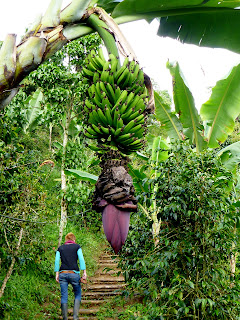Most people know
that Colombia is big in coffee, several things most people probably don’t know
is that it’s second only to oil as a traded commodity, Colombia is the third
largest exporter of coffee in the world, and exactly how Colombian coffee goes from a seed in the ground to a
triple shot of espresso served at Starbucks. Lucky for me
(and you) I stayed at a very cool hostel, The Plantation House, the owners of which
also own a small coffee farm and offer tours to explain the whole process.
I’ll skip a
lot of the more complicated and boring parts (like the different between the
types, traditional variety coffee vs modern variety, the effect of shade, or
the reason the roots need to grow straight down in order to produce quality
coffee) and just move onto the basics.
So, the
process starts with a bag of coffee beans that have been soaked, dried, and
sorted. The beans can either be moved
onto the next process that results in an actual cup of coffee, or planted in
the ground to start the growing process over.
Beans
planted in the ground go through a delicate growing process. To keep the roots straight they are grown in
individually potted bags, before finally getting planted in the ground after a
year. Three to five years after the bean
has been placed in soil, the coffee plant produces a flower and then coffee
cherries. Twice a year during the wet
season (around November and May), they have a harvest and collect all the ripe
red or yellow cherries, inside of each are two identical beans.
These beans
are all collected, removed from the skin, and then soaked in water to remove
the natural sugar coating each bean.
This soaking process leads to fermentation and alcohol. The restaurant around the corner from the
hostel makes a coffee wine from the alcohol.
We tried after the tour and it was really good, sweet, with a hint of
coffee.
 |
| Coffee wine |
After
cleaning off all the sugar, the coffee is then dried, all beans with defects
removed, and finally sold. Strangely,
there are tons of different types of coffee being grown, with red and yellow
cherries, yet once the skin as been removed, all coffee beans look
identical. Hence, most coffee that
people drink is a blend of many different types, and coffee isn’t sold on the
basis of type. It is priced how
something rightfully should be, with bigger naturally ALWAYS being better,
coffee beans are priced with big beans being the best and hence most expensive.
All the
beans that result are where we started, those beans can either be planted it to
the ground, or sold at market for profit.
The beans move from the farmer to another party, where several
additional layers of skin are removed, and again defective beans are removed,
leaving a green looking bean that is ready to be roasted. The green beans last for months without
spoiling, so the coffee that is being transported around the world are these
green beans. Coffee only gets roast
right before it gets drunk, therefore the drinking country generally does the
roasting. A common misconception is that
the darker the roast, the more bitter the coffee tastes, and the less caffeine
it has, and vice verso. So good coffee with
a nice flavor is generally roasted mild, leaving more of the flavor and
caffeine intact.





I know you like equations so...
ReplyDeletebamboo forest picture = most awesome picture ever + 2